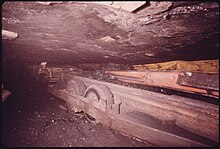Shuttle car
A shuttle ( English shuttle car ) is a selbstentladendes Gleislosfahrzeug that in underground mining for the promotion of the recovered ore , coal or salts is used. The shuttle cars are among the discontinuous or shuttle conveyors.
history
The shuttle cars were developed in the USA in the 1930s. The first vehicles were introduced in a coal mine in 1938 ; in 1954, 5,000 shuttle cars were already in use in the North American hard coal mine for mining . By using these vehicles, it was no longer necessary to lay tracks. In the first set shuttle it was storage battery powered vehicles. Shuttle cars with cable supply were later developed and used underground. The accumulator vehicles were scrapped from around 1950.
construction
A shuttle car consists of a base frame in the middle of which the load is carried. In the middle of the base frame there is a scraper chain conveyor with which the goods are moved. The drive mechanism is located on the sides of the vehicle. The vehicle is equipped with either rubber-tyred wheels or caterpillar chains for locomotion. It is driven by a diesel or electric motor. Electrically powered vehicles are supplied with electricity either by accumulators or via a tow cable . Due to their limited capacity, battery vehicles are rarely used today. Diesel vehicles are mainly used outside of coal mining. Vehicles with cable drums are predominantly used in coal mines. Between 152 and 244 meters of cable can be wound on the cable drum. The cable length determines the maximum range of the vehicle. There are vehicles with DC and three-phase drives . The driver's seat is on the side of the vehicle. There are differently constructed cabs . Most vehicles have cabs with two seats in a row, in opposite directions. However, these vehicles only have one steering wheel. To change the direction of travel, the driver must change his seat. As a result, he always looks in the direction of travel and can drive forwards after charging without having to turn around. To move the vehicle, the driver has an accelerator pedal and a brake pedal. The vehicles weigh between 8 and 31.8 tons and are up to 7 meters long. By installing brackets of different heights, the vehicles can achieve different loading capacities. Depending on the vehicle, their loading capacity is between 4 and 15 m³, which corresponds to up to 35 tons .
commitment
DC vehicles are more likely to be used for flat stretches . For routes with an incline of more than 15 gons , vehicles with AC drives are preferred. The vehicles shuttle back and forth between the continuous miner and the conveyor transfer point. Since the mining machine can only store the extracted coal to a limited extent, several vehicles are required per operation. As a rule, two to three vehicles commute between a mining machine and the belt feed station. To load the coal onto the loading area, the shuttle car drives from one side behind the continuous miner. There the coal is placed on the internal chain conveyor and transported with the chain conveyor to the other end of the vehicle. In order to achieve an even loading, the conveyor is loaded at a slow speed. After the vehicle has been loaded, it is driven to the belt loading station and unloaded using the chain conveyor. The chain conveyor is then operated at high speed during unloading. This minimizes the discharge time.
Individual evidence
- ↑ a b Coal Glossary. (PDF file; 39 kB) Archived from the original on November 19, 2011 ; Retrieved August 11, 2013 (American English).
- ^ A b c d e Fritz Heise, Fr. Herbst, Carl Hellmut Fritzsche: Bergbaukunde . Textbook of, with special consideration of the coal mining industry. 9th completely revised edition. 1st volume. Springer-Verlag, Berlin / Göttingen / Heidelberg 1957, p. 371 .
- ↑ a b c d e Eric Drüppel: Development of a concept for the cutting extraction in rock salt . Ed .: Rheinisch-Westfälische Technische Hochschule Aachen . 2010 (dissertation).
- ^ A b Thomas W. Garges: Underground Mining Technology Evolution. (PDF file; 6.92 MB) Department of Mining Engineering, College of Engineering and Mineral Resources West Virginia University, archived from the original on September 4, 2012 ; Retrieved August 11, 2013 (American English).
- ^ A b c Robin Burgess-Limerick: Reducing injury risks associated with underground coal mining equipment. (pdf, 5.56 MB) Burgess-Limerick & Associates, 2010, p. 38 , accessed on August 11, 2013 (American English).
- ↑ a b c d Richard L. Breithaupt: Shuttle Cars. (PDF file; 282 kB) Retrieved August 11, 2013 (American English).
- ↑ a b Haulage Systems Product Overview. Joy Mining Machinery, accessed August 11, 2013 (American English).
- ^ K. Nienhaus: Productivity instead of size. Highly productive mining in CM operations.
- ^ K. Nienhaus: Longwall and Örterbau - competition and supplement . In: Glückauf 136, trade journal for raw materials, mining and energy. No. 6, VGE Verlag Essen, Essen 2000, ISSN 0340-7896 .
- ^ A b Marinus J. Pouls: Transport Technology in Room and Pillar Coal Operations. (PDF file; 3.57 MB) In: Mining Reporters Glückauf 1-2010. Archived from the original on May 14, 2012 ; Retrieved August 11, 2013 .
Web links
- Pioneering underground mining. JoyMiningMachinery, accessed August 11, 2013 (Shuttle Car in action (video)).
